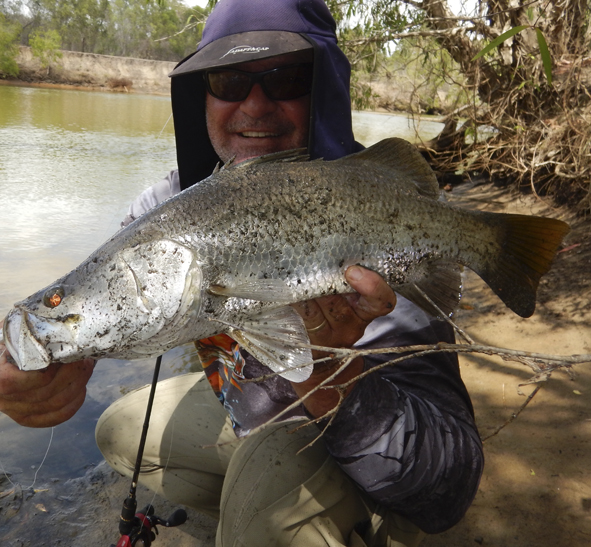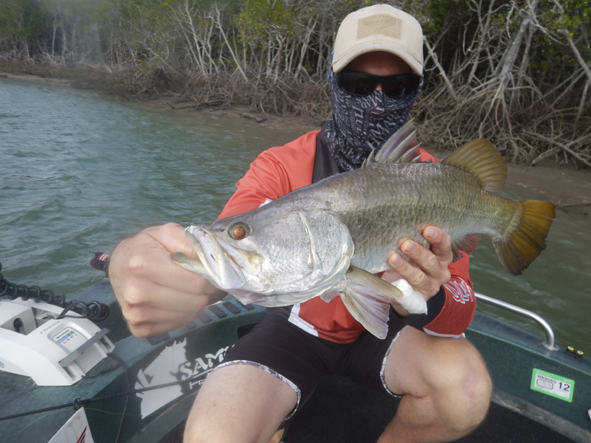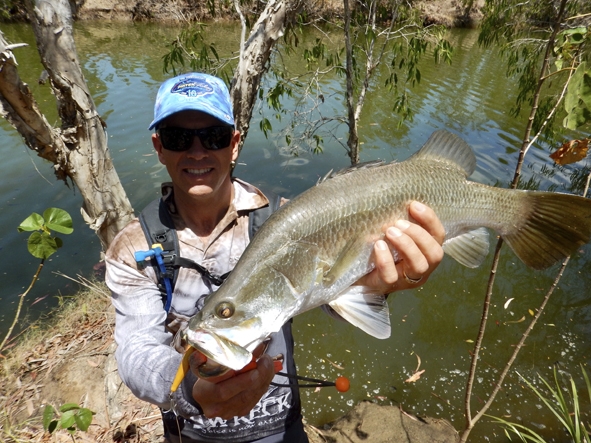Getting the Tide Right – by Dave Hodge
So many fishing related pursuits are carried out based on the time and size of the tides and the accessibility they allow to various locations. But there is more to it than just having enough water to float your boat.
Many fish species travel the systems with the tides, depending on how much water penetrates the upper reaches of the estuary systems, fish will move congregate, or at least travel through each area when they have access.
In the lower reaches, or around the mouths of many estuary systems, feed times often coincide with a tide change, and being ready for this sometimes relatively short bite window is imperative in order to make the best of those opportunities.
Try  and have in mind an area that you believe to be holding fish and be there, rod in hand, and ready to fish when the action starts – hopefully.
and have in mind an area that you believe to be holding fish and be there, rod in hand, and ready to fish when the action starts – hopefully.
There are so many variable opportunities though, and in some locations, you need to be there as the tide draws from the mangroves and standing structure to intercept the predators such as barra and jacks, who will position themselves ready to ambush or at least capitalise on the fact that food will absolutely be funneling out of a drain or creek.
Yes, fish will cruise the barren flats scanning for bait that have lost the refuge of the mangroves, and have to run the gauntlet of veracious predators lurking in the murk, just looking for a feed.
While these seem to be simply overlooked at times by anglers, there are plenty of fishos who realise the potential of the flats and being a specialist pursuit, require shallow draft boats, equipped with electric motors.
For anglers who’s hull designs are more meant for the open water, deeper ‘V’ transforms and bows that draw more water, it usually means that the timing for these flats areas is negated by physics more so than timing.
A deep hull won’t allow access to these shallow areas at the right times, so other areas need to be targeted.
Luckily in the many estuary systems of the north, these smaller arterial waterways that join the main river systems and channels are access points which allow just about any boat under 5m to enter.
It’s important though to negotiate an arterial waterway quietly and carefully as you approach or work your way up towards a channel, especially if your passing flats areas along the way.
What I mean here is, you don’t want to be driving past fish to find fish.
The want of being as far up a drain as you can to offer the longest opportunity at targeting fish as they exit these drains is actually quite a solid theory, but there are occasions when fish schools congregate towards the entrances of these bigger drains, and generally speaking they’re hyped and ready to take your lure of choice.
This is of course is more suitable for bigger boats also, as it eliminate the need to push as far up a shallow drain as possible (and risking being stranded), though only for a small amount of time if it’s the last of the run-out tide.
It’s this unpredictable variable that sees us drop the electric, turn the stereo off, or at least down and make sure that there’s no thumping on the hull or any other noise that can see bow waves of panicked fish bolting from our clumsy intrusion.
One more thing before I move on from this part, and that is to keep a sharp eye on the sounder as there can be mud banks and humps, rock bars, submerged log jams etc that can go undetected as you work your way up a drain which can deny you the option of a retreat as the water level drops.
Our electric motor is our depth gauge, and once our electric begins to rub bottom, it’s time to make a retreat to deeper water.
This may mean only a short retreat of 50m or so at times, but at other times may mean a mad dash for a couple of hundred metres to reach the sanctuary of deeper water.
Colour changes are often referred to as natural indicators of a holding location for fish laying in wait for oblivious bait, charging out from the murk in a lightning fast attack, then slinking back to the cover in wait the next opportunity.
These colour changes are almost always associated with a junction or intersection of adjoining drains.
These sign posts are the more easily identified areas to target your efforts, and as with any form of lure casting, the angler is looking for a point of difference on a predominantly barren or featureless bank.
Other indicators for angler effort are, individual logs or trees either standing or fallen, sharp ridge lines of sand, mud or a conglomerate that redirect water flow, hollows or depressions in the bottom contour and so on.
These points of difference are naturally what fish often seek out, and once you begin to be able to identify or take notice of these frequent and important locations, you’ll find there are lots more areas to target than what you first imagined.
The upper extremities of estuaries often deem them inaccessible by boat, and if you can gain lawful access to these areas, then it’s often a myriad of fallen snags and structure to focus your casting efforts on.
One place I fish has a stretch of water that has at least 15 big fallen trees spread out over a 100m stretch, each holding several fish per snag, and it can take me sometimes an hour to cover this snag laden piece of brackish heaven.
It’s riddled with smaller branches and rocks also which hold fish but generally speaking, the best snags usually hold the best, or at least the most fish.
While it’s possible to catch at least a few fish here at any stage of the tide, it’s the timing which will determine the amount of action you’re going to encounter.
A simple equation to go by is the further a system stretches inland, the longer time frame there will be between a tide change at the mouth where it joins the ocean or bay, and the upper reaches. I’ll define this a little more precisely so as you don’t misinterpret what I’m saying.
Let’s say that a shorter river system of say, 2 Kms long, has a time delay of an hour from when the tide change begins at the mouth, to when you can notice a change in the upper brackish reaches.
Comparatively speaking, a long meandering system that can be twenty Kms from mouth to upper reaches may take as long as 3 to 4 hours before the tidal fluctuation begins.
That area I mentioned earlier is just as described, and if there is a low tide predicted at say 10am at the mouth, then I know that if I want to fish the bottom of the tide in the upstream location, I need to time it for around 1.30 to 2 o’clock, around three and a half hours later than the mouth.
If you ever get the chance, speak to world renowned barra guide Lindsay Dobe who also owns Barra World at Proserpine, and ask him about the corresponding tidal changes for dam or impoundment fish, and the best times to focus your efforts on the land locked monsters.
Solar effects and gravitational influence have affects even though there is a dirty great big wall separating the rivers and backed up waters of a dam.
His knowledge on the subject is phenomenal, and his experience and credibility undeniable and well documented.
Now whether this time of lower water means that more fish are condensed into more concentrated areas which are more easily identified, or there is a compulsion for these fish to feed more veraciously at times of low water, I have no idea, but the fact remains that this is the most productive times for us to fish the upper reaches, so timing is everything.

The fact that I never name spots, locations or give out GPS marks is no accident, and many of these spots are easily impacted and don’t have the schools of transient fish replenished quickly enough to top up populations of resident predators if the wrong people find access.
No matter that the fish from these upper reaches have often been living in that environment for long periods of time and are nowhere near the eating quality of salty residents, some unscrupulous individuals will abuse these areas, totally devastating them long term.
If you do access somewhere like what has been described above, then keep it under your hat.
I’m a firm believer that many young budding journalists assume that they will gain some sort of credibility by exposing untouched or lesser frequented waters, often shown to them by a trusting individual who couldn’t dream that their honey hole be exposed, or trust betrayed.
Sadly, that’s not the case, no matter how much we’d like to think that.
Cheers and good luck in the search. Hodgie.





